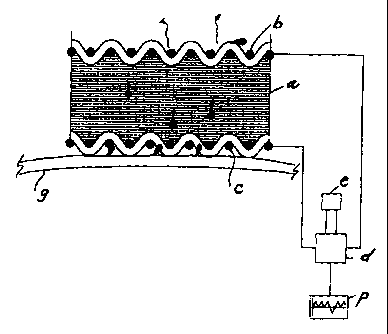Some of the information on this Web page has been provided by external sources. The Government of Canada is not responsible for the accuracy, reliability or currency of the information supplied by external sources. Users wishing to rely upon this information should consult directly with the source of the information. Content provided by external sources is not subject to official languages, privacy and accessibility requirements.
Any discrepancies in the text and image of the Claims and Abstract are due to differing posting times. Text of the Claims and Abstract are posted:
| (12) Patent: | (11) CA 2295710 |
|---|---|
| (54) English Title: | METHOD OF FLUID TRANSPORT |
| (54) French Title: | PROCEDE DE TRANSPORT DE LIQUIDE |
| Status: | Expired and beyond the Period of Reversal |
| (51) International Patent Classification (IPC): |
|
|---|---|
| (72) Inventors : |
|
| (73) Owners : |
|
| (71) Applicants : |
|
| (74) Agent: | SMART & BIGGAR LP |
| (74) Associate agent: | |
| (45) Issued: | 2007-08-21 |
| (86) PCT Filing Date: | 1998-06-29 |
| (87) Open to Public Inspection: | 1999-01-07 |
| Examination requested: | 2003-06-25 |
| Availability of licence: | N/A |
| Dedicated to the Public: | N/A |
| (25) Language of filing: | English |
| Patent Cooperation Treaty (PCT): | Yes |
|---|---|
| (86) PCT Filing Number: | PCT/NO1998/000198 |
| (87) International Publication Number: | WO 1999000166 |
| (85) National Entry: | 1999-12-29 |
| (30) Application Priority Data: | ||||||
|---|---|---|---|---|---|---|
|
There is described a method for the transport of liquid in textiles or porous
structures, whereby the liquid is forced to travel through
the textile(s) with the aid of electric pulses applied to a conductor or semi-
conductor which is woven onto, or in some other fashion applied
to, each side of the material which may be a single textile or several layers
of textiles which together form a laminate.
L'invention concerne un procédé de transport de liquide dans des textiles ou des structures poreuses, le liquide étant envoyé de force à travers le ou les textiles à l'aide d'impulsions électriques appliquées sur un conducteur ou un semi-conducteur tissé de chaque côté du matériau, ou appliqué d'une autre manière sur ce dernier, lequel peut être formé d'un seul textile ou de plusieurs couches de textiles qui forment ensemble un stratifié.
Note: Claims are shown in the official language in which they were submitted.
Note: Descriptions are shown in the official language in which they were submitted.

2024-08-01:As part of the Next Generation Patents (NGP) transition, the Canadian Patents Database (CPD) now contains a more detailed Event History, which replicates the Event Log of our new back-office solution.
Please note that "Inactive:" events refers to events no longer in use in our new back-office solution.
For a clearer understanding of the status of the application/patent presented on this page, the site Disclaimer , as well as the definitions for Patent , Event History , Maintenance Fee and Payment History should be consulted.
| Description | Date |
|---|---|
| Inactive: IPC expired | 2019-01-01 |
| Time Limit for Reversal Expired | 2017-06-29 |
| Letter Sent | 2016-06-29 |
| Grant by Issuance | 2007-08-21 |
| Inactive: Cover page published | 2007-08-20 |
| Inactive: Final fee received | 2007-05-24 |
| Pre-grant | 2007-05-24 |
| Inactive: Final fee received | 2007-05-24 |
| Letter Sent | 2007-04-20 |
| Letter Sent | 2007-04-20 |
| Inactive: Single transfer | 2007-02-19 |
| Inactive: Office letter | 2007-01-12 |
| Inactive: Corrective payment - s.78.6 Act | 2007-01-02 |
| Notice of Allowance is Issued | 2006-11-30 |
| Letter Sent | 2006-11-30 |
| Notice of Allowance is Issued | 2006-11-30 |
| Inactive: First IPC assigned | 2006-11-26 |
| Inactive: Approved for allowance (AFA) | 2006-10-30 |
| Amendment Received - Voluntary Amendment | 2006-08-09 |
| Inactive: IPC from MCD | 2006-03-12 |
| Inactive: IPC from MCD | 2006-03-12 |
| Inactive: S.30(2) Rules - Examiner requisition | 2006-02-24 |
| Letter Sent | 2003-07-23 |
| Request for Examination Received | 2003-06-25 |
| Request for Examination Requirements Determined Compliant | 2003-06-25 |
| All Requirements for Examination Determined Compliant | 2003-06-25 |
| Letter Sent | 2002-11-04 |
| Reinstatement Requirements Deemed Compliant for All Abandonment Reasons | 2002-10-28 |
| Deemed Abandoned - Failure to Respond to Maintenance Fee Notice | 2002-07-02 |
| Inactive: Entity size changed | 2001-12-21 |
| Letter Sent | 2000-04-07 |
| Inactive: Single transfer | 2000-03-08 |
| Inactive: Cover page published | 2000-03-02 |
| Inactive: First IPC assigned | 2000-03-01 |
| Inactive: Courtesy letter - Evidence | 2000-02-22 |
| Inactive: Notice - National entry - No RFE | 2000-02-17 |
| Application Received - PCT | 2000-02-11 |
| Application Published (Open to Public Inspection) | 1999-01-07 |
| Abandonment Date | Reason | Reinstatement Date |
|---|---|---|
| 2002-07-02 |
The last payment was received on 2007-05-28
Note : If the full payment has not been received on or before the date indicated, a further fee may be required which may be one of the following
Please refer to the CIPO Patent Fees web page to see all current fee amounts.
Note: Records showing the ownership history in alphabetical order.
| Current Owners on Record |
|---|
| OSMOLIFE AS |
| Past Owners on Record |
|---|
| OLAV ELLINGSEN |
| TROND EIDSNES |